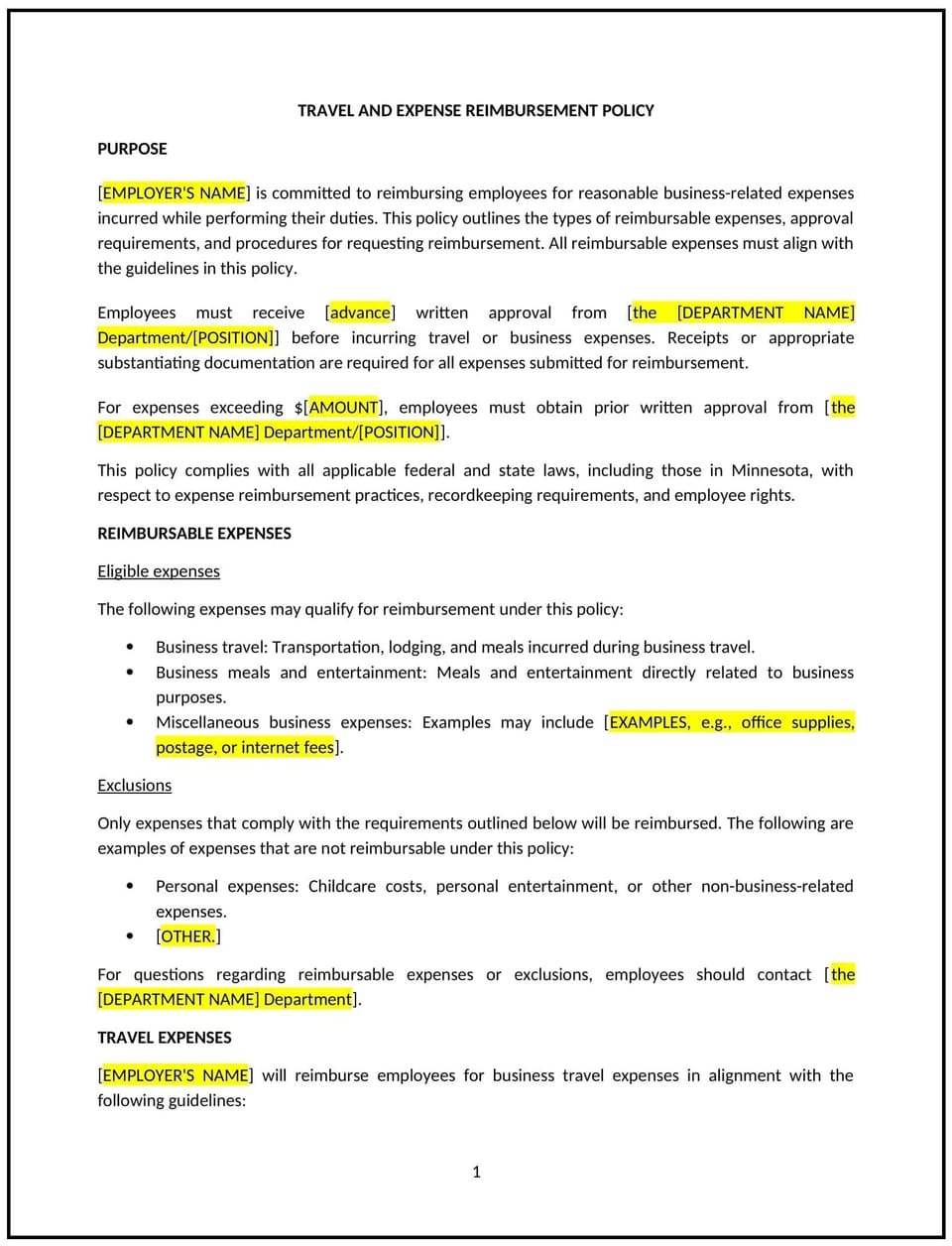Travel and expense reimbursement policy (Minnesota): Free template

Travel and expense reimbursement policy (Minnesota)
This travel and expense reimbursement policy is designed to help Minnesota businesses establish clear guidelines for managing employee travel and related expenses. Whether businesses are handling local travel, out-of-state trips, or international assignments, this policy provides a framework to ensure fair and consistent reimbursement practices. Tailored to Minnesota’s business environment, this policy emphasizes transparency, accountability, and cost control.
By implementing this policy, businesses in Minnesota can streamline expense management, reduce financial risks, and support employees during work-related travel.
How to use this travel and expense reimbursement policy (Minnesota)
- Define eligible expenses: Clearly outline which expenses are reimbursable, such as airfare, accommodations, meals, transportation, and incidental costs.
- Set spending limits: Provide guidelines for reasonable spending limits on categories like lodging, meals, and transportation.
- Establish approval processes: Specify the steps employees must follow to request pre-approval for travel and submit expense reports.
- Include documentation requirements: Require employees to provide receipts, invoices, or other proof of payment for all reimbursable expenses.
- Address payment timelines: Outline the timeframe for submitting expense reports and receiving reimbursements.
- Provide guidelines for non-reimbursable expenses: List expenses that are not eligible for reimbursement, such as personal purchases or non-business-related activities.
- Review and update the policy: Regularly assess the policy’s effectiveness and make adjustments as needed to reflect changes in business needs or travel trends.
- Communicate the policy: Share the policy with employees during onboarding and through internal communications to ensure awareness and understanding.
Benefits of using this travel and expense reimbursement policy (Minnesota)
This policy offers several advantages for Minnesota businesses:
- Promotes transparency: Clear guidelines help employees understand what expenses are reimbursable and how to submit claims.
- Controls costs: Spending limits and approval processes help manage travel budgets effectively.
- Reduces financial risks: Proper documentation and review of expenses minimize the risk of fraud or errors.
- Supports employees: Fair and timely reimbursement practices demonstrate the business’s commitment to supporting work-related travel.
- Enhances efficiency: Structured processes for approvals and reimbursements streamline expense management.
- Builds trust: A transparent and consistent policy fosters trust between employees and management.
- Aligns with best practices: The policy reflects modern standards for travel and expense management.
Tips for using this travel and expense reimbursement policy (Minnesota)
- Communicate the policy effectively: Share the policy with employees during onboarding and through regular training sessions.
- Provide tools and resources: Offer employees access to expense management software or templates for submitting expense reports.
- Monitor spending: Regularly review expense reports to ensure compliance with the policy and identify opportunities for cost savings.
- Be consistent: Apply the policy uniformly to all employees to avoid perceptions of favoritism or bias.
- Encourage feedback: Regularly seek input from employees on how the policy can be improved to better meet their needs and the business’s goals.
- Review the policy periodically: Update the policy as needed to reflect changes in business needs, travel trends, or industry standards.
Q: Why should Minnesota businesses adopt a travel and expense reimbursement policy?
A: Businesses should adopt this policy to promote transparency, control costs, and support employees during work-related travel.
Q: What expenses are typically reimbursable under this policy?
A: Reimbursable expenses should include airfare, accommodations, meals, transportation, and incidental costs directly related to business travel.
Q: How should businesses set spending limits?
A: Businesses should provide reasonable spending limits for categories like lodging, meals, and transportation, based on industry standards and budget constraints.
Q: What documentation is required for reimbursement?
A: Employees should provide receipts, invoices, or other proof of payment for all reimbursable expenses.
Q: How long should employees wait for reimbursement?
A: Businesses should outline a clear timeframe, typically within 15 to 30 days, for submitting expense reports and receiving reimbursements.
Q: What expenses are not reimbursable?
A: Non-reimbursable expenses should include personal purchases, non-business-related activities, and expenses exceeding established spending limits.
Q: How often should the policy be reviewed?
A: The policy should be reviewed annually or as needed to reflect changes in business needs, travel trends, or industry standards.
This article contains general legal information and does not contain legal advice. Cobrief is not a law firm or a substitute for an attorney or law firm. The law is complex and changes often. For legal advice, please ask a lawyer.


